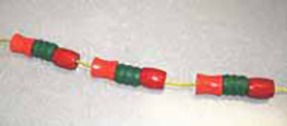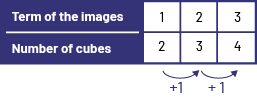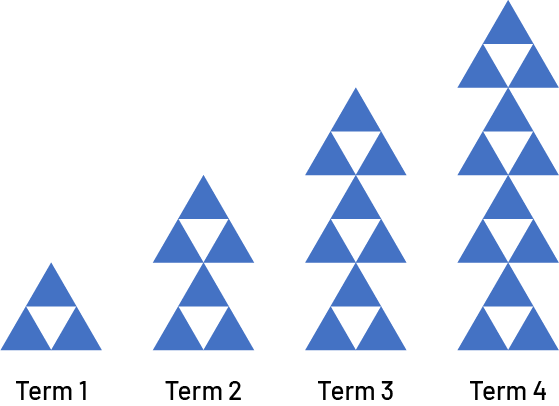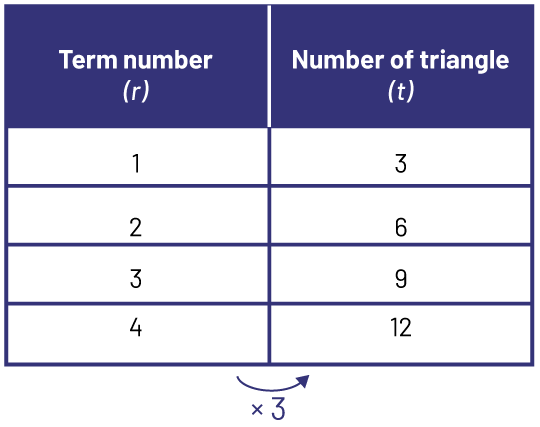C1.1 Identify and describe repeating and growing patterns, including patterns found in real-life contexts.
Skill: Recognizing and Describing Repeating Patterns
The repeating pattern is the simplest form of pattern. To recognize it, we must look for the pattern core. It is created when the elements that make up the pattern repeat in the same order. Students must learn to identify the beginning and end of the pattern core. In the picture below, for example, the student who created this pattern shows, leaving a space between the patterns, that the orange bead indicates the beginning of the pattern and the red bead indicates the end. In addition, it is important to have students "read" the pattern by naming and touching each consecutive element of the pattern to identify the repetition.

From Kindergarten through to the end of the junior grades, the patterns that students learn to explore and create should be increasingly complex. When teaching repeating patterns, it is important to consider the following guidelines.
- Spot false leads: Recognizing that an attribute can be a false lead in a pattern. It is important for students to recognize the attribute(s) upon which the pattern is based.
- Modify the structure of the pattern: Explore more complex patterns, adding more elements to the pattern or more attributes. Students will then face a cognitive challenge that will lead to new learning.
- Change the representation: Present patterns with different representations of the same structure and check if the students recognize that they have the same structure.
- Explore patterns with a missing element in the pattern: Examining the pattern to determine what element is missing from the beginning, middle, or end of a pattern increases student understanding of relationships. Many activities like this help students understand that the pattern, as a whole, may contain several smaller repeating elements, rather than seeing it as a collection of changing elements with no relationship to each other.
Examples
Pattern A

In Pattern A, the colours used are not an attribute of the pattern. Therefore, students should ignore the colour attribute and stick to the shape attribute (triangle or circle).
Pattern B

In Pattern B, the different shapes and colours create false leads that must be ignored in order to discover the attribute, that is, the position of the base (shape placed on a flat side or on a vertex).
Source: translated from Guide d’enseignement efficace des mathématiques de la maternelle à la 3e année, Modélisation et algèbre, Fascicule 1, Régularités et relations, p. 30-33.
Skill: Recognizing and Describing Growing Patterns
To recognize a growing geometric pattern, we must look for the relationship between each shape (recursive relationship), or the pattern between the term number and the term (functional relationship). The number of elements that make up a shape increases from one term to the next.
Source: translated from En avant, les maths!, 3e année, CM, Algèbre, p. 3.
A relationship can be represented by a situation that is expressed using a pattern of concrete or semi-concrete shapes or using words. The study of relationships should first involve situations expressed using patterns because these situations have a visual and kinesthetic dimension that makes the relationships they represent less abstract.
Example of a Growing Pattern

Structuring increasing geometric patterns can support students in recognizing and describing them.
For example, structuring the elements that make up each shape in the pattern can show:
- a consistent change (e.g., a sun is added at the end of each branch);
- the constant (e.g., three suns placed in a "V" shape).
Note: Colour can be used to highlight the basic pattern or starting shape.

- The number of elements that make up each figure and their positions are predictable. In the following, for example, it can be predicted that the shape in the 5th row will be composed of the basic pattern, three suns placed in a V-shape, and four more suns on each branch. It will thus be composed of 11 suns in all.
When an increasing geometric pattern is not structured, as in the example below, it can be more difficult for students to recognize what elements are increasing. Both geometric patterns have an increase in suns from one figure to the next, i.e., 3, 5, 7, …

Source: translated from Guide d’enseignement efficace des mathématiques de la 4e à la 6e année, Modélisation et algèbre, p. 42-43.
Contextual situations can also be used for students to explore a variety of pattern rules. Below are some examples:
Note: It is important to choose learning situations in which finding a rule is within the reach of the students.
Example 1
Dominique is saving up to buy a video game that costs $74 (including taxes). She only has $35 in her wallet. Every week, her parents give her $5, which she keeps in her wallet.
| Weeks | 1 | 2 | 3 | … | … | … |
|---|---|---|---|---|---|---|
| Amount of Money in Dominique's Wallet | 40 | 45 | 50 | … | … | … |
Describe the growing pattern.
Recursive Pattern Rule Involving Addition
The relationship between the amount of money in Dominique's wallet from week to week can be represented by a table of values. Each term increases by a value of 5 from the value of the previous term.

Functional Relationship
The relationship between the number of weeks passed and the amount of money in the wallet can be represented using words.
On week 1, Dominique has $35 and 1 $5 bill in her wallet, which gives her $40.
On week 2, Dominique has $35 and 2 $5 bills in her wallet, giving her $45.
On week 3, Dominique has $35 and 3 $5 bills in her wallet, giving her $50.
On week 4, Dominique has $35 and 4 $5 bills in her wallet, giving her $55.
On week 5, Dominique has $35 and 5 $5 bills in her wallet, giving her $60.
Example 2
Emily babysits regularly. A couple asks her to look after their child for 6 hours a day for 10 days and offers to pay her according to the following table of values.
| Days | 1 | 2 | 3 | 4 | … |
|---|---|---|---|---|---|
| Salary for the day ($) | 1 | 2 | 4 | 8 | … |
Describe the growing pattern.
Recursive Pattern Rule Involving Multiplication
I noticed that the salary doubles every day. So the pattern rule is ×2.

Source: translated from Guide d’enseignement efficace des mathématiques de la 4e à la 6e année, Modélisation et algèbre, p. 35-37.
Knowledge: Geometric Patterns
Geometric pattern: Set of shapes or objects arranged according to a pattern rule.
Repeating Pattern
A set of shapes or objects arranged in an orderly fashion, in which a repeated pattern (pattern core) can be found.
Pattern A

Growing Pattern
A set of shapes or objects arranged in which the number of elements increases one term to the next.
Examples

Example 1 shows a growing pattern in which 1 square is added to each subsequent term.
Example 2 shows a spiral shell, whose 1st term (basic pattern) is the first spiral in the centre of the shell. The other terms are obtained according to a certain regularity (often associated with the Fibonacci pattern and the golden ratio). The pattern formed by the different spirals is a growing pattern because the size of the spirals increases according to a pattern rule.
Example 3 represents a pyramid, whose first term is a rectangular prism at the top, to which are added blocks whose base area grows according to a certain pattern rule.
Source: Ontario Curriculum, Mathematics Curriculum, Grades 1-8, 2020, Ontario Ministry of Education.
Knowledge: Numeric Patterns
Growing Numeric Pattern
A pattern where the terms are numbers that increase. The terms of a growing pattern can be generated from regularities involving addition and multiplication of whole numbers.
Examples
- 4, 6, 8, 10, … (The pattern rule is +2. It is possible to deduce the next term in the pattern by adding 2; for example, 10 + 2 = 12)
- 1, 3, 5, 7, 9, 11, … (The pattern rule is +2. It is possible to deduce that the next term will be 13, that is, 11 + 2 = 13)
- 3, 9, 27, 81, … (The pattern rule is ×3. It is possible to deduce that the next term will be 243, that is, 81 × 3 = 243.)
Shrinking Numeric Pattern
A pattern where the terms are numbers that decrease. The terms of a shrinking pattern can be genereated from regularities involving subtraction and division of whole numbers.
Examples
- 14, 11, 8, … (Subtract three to get the next term.)
- 144, 72, 36, … (Divide by two to obtain the next term.)
Knowledge: Pattern Core
Pattern core: Composition of the least number of elements in a pattern from which a pattern rule can be created.
Repeating Pattern
Pattern A

The pattern core is:

Growing Pattern
Pattern B

The pattern core is:

By examining each of the terms in a pattern, we can recognize that they are created by building on the pattern core, since we can see the core within each term.
Knowledge: Attribute
Attribute: A characteristic that describes an object that is observed or manipulated. Attributes can include colour, shape, texture, thickness, orientation, materials, motion, sounds, objects, or letters. The attributes that describe Pattern A below are shape and colour.
Pattern A

Knowledge: Term
Term: A term or a position number in a pattern is comprised of at least on value or element (e.g., shape, object, or motion).
Repeating Pattern
In Pattern A, each of the shapes is a term.
Pattern A

1st term:

2nd term:

3rd term:

Growing Geometric Pattern
Pattern B
In Pattern B, each of the shapes is a term.

Shrinking Geometric Pattern
In Pattern C, each of the shapes is a term.
Pattern C

1st term:

2nd term:

3rd term:

Growing Number Pattern
2, 4, 6, 8, …
4, 10, 16, 22, 28, …
Knowledge: Pattern Rules
Recursive pattern rule: a rule that is based on the relationship between one term and the next.
Repeating Pattern
Pattern A

Pattern rule in Pattern A: repeat the blue rectangle, green trapezoid, orange triangle pattern, always in the same order.
Note: Describing the pattern core is the pattern rule for a repeating pattern.
Growing Pattern
Recursive pattern rule in Pattern B: the number of squares increases by one from term to term.
Pattern B

Recursive pattern rule in Pattern C: the number of cubes increases by one from term to term.
Pattern C


Functional Pattern Rule: a rule that is based on a generalization of the relationship between any term number and its associated term value.
In the first pattern below, the pattern rule is that the number of triangles in the shape is three times its term number. In the second pattern, the green triangle is constant from one term to the next and a group of two orange squares is always added to the next term.


 Image 1st row, there is 1 green triangle and 1 group of 2 orange squares. 2nd row, there is 1 green triangle and 2 groups of 2 orange squares. 3rd row, there is 1 green triangle and 3 groups of 2 orange squares. 4th row, there is 1 green triangle and 4 groups of 2 orange squares.
Image 1st row, there is 1 green triangle and 1 group of 2 orange squares. 2nd row, there is 1 green triangle and 2 groups of 2 orange squares. 3rd row, there is 1 green triangle and 3 groups of 2 orange squares. 4th row, there is 1 green triangle and 4 groups of 2 orange squares.
|
In the 1st position, there is 1 green triangle and 1 group of 2 orange squares. In the 2nd position, there is 1 green triangle and 2 groups of 2 orange squares. In the 3rd position, there is 1 green triangle and 3 groups of 2 orange squares. In the 4th position, there is 1 green triangle and 4 groups of 2 orange squares. |
Knowledge: Repeating Pattern Rule Structure
Repeating pattern rule structure: letters used to represent the pattern rule of a repeating pattern.
In Pattern A, each element of the pattern can be identified by a letter as follows: blue rectangle (A), green trapezoid (B), orange triangle (C). The repeating pattern rule structure of Pattern A is therefore ABC.
Pattern A

